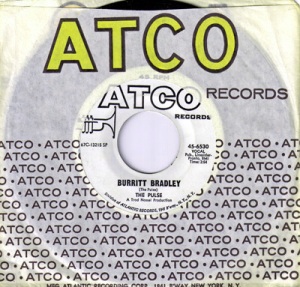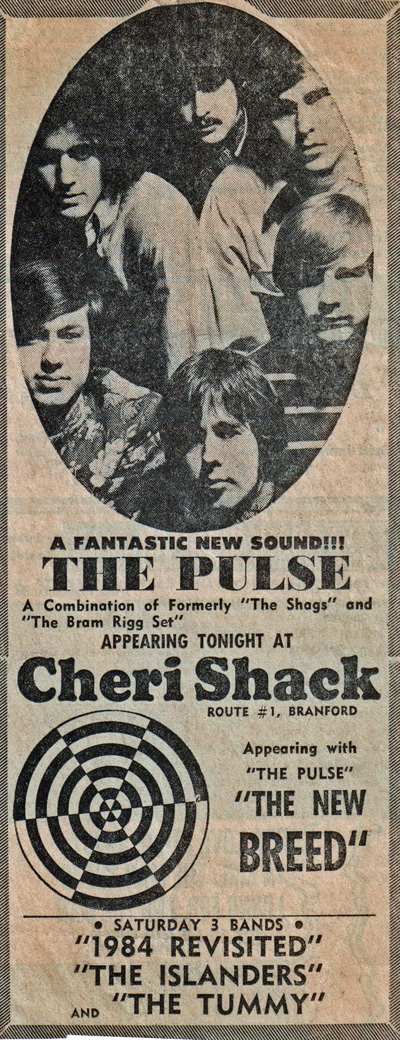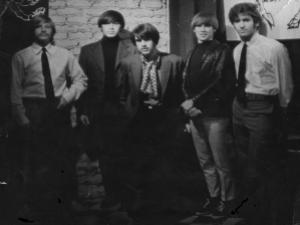To recap part 2: At the end of the summer of 1967, two popular New Haven-based bands broke up at the prodding of manager/producer Doc Cavalier, who owned Syncron Studios (later Trod Nossel) in Wallingford. Three members from the Shags and three from the Bram Rigg Set joined to form The Pulse (the actual original name was The Pulse of Burritt Bradley). But after a failed single released on ATCO, the bubblegum confection Can-Can Girl, the group broke up after about six months. Pulse, a blues-rock outfit emerged with now four members from Bram Rigg Set, one lone survivor of the Shags and a new addition.
 In January, 1968, Pulse started rehearsing in earnest to play some live dates and start recording its first album. The first gig was to be at a small club in Watertown, the Shack. We used to rehearse in what was called the Shed in back of Syncron Studios. The rehearsal room was an unfinished concrete-floored area no larger than a two-car garage with 2×4 framing exposed on the first floor of what looked like an old barn. This was perhaps the most dangerous place I’ve ever rehearsed, yet we carried on in the Shed for 2-plus years as Pulse.
In January, 1968, Pulse started rehearsing in earnest to play some live dates and start recording its first album. The first gig was to be at a small club in Watertown, the Shack. We used to rehearse in what was called the Shed in back of Syncron Studios. The rehearsal room was an unfinished concrete-floored area no larger than a two-car garage with 2×4 framing exposed on the first floor of what looked like an old barn. This was perhaps the most dangerous place I’ve ever rehearsed, yet we carried on in the Shed for 2-plus years as Pulse.
The danger lay in the ceiling, which was probably less than a foot above everyone’s heads. In fact, there was no ceiling, instead it was the foil side of insolation tucked in between the framing. So, if you happened to lift the neck of your guitar a little too high as when you were taking if off and your hands were touching the strings, you were in for a maximum jolt of electricity, the kind that tenses your entire body. I’ve had a few of those in my days, several from the Shed and it is as you may know no fun and rather scary. Still, we persevered.
 Soon after forming, we added a sixth member, Jeff Potter, who played a mean blues harp and also added percussion with a conga drum and eventually occasional keyboards. Ray Zeiner, the keyboard player from the Wildweeds, had recommended him. Jeff and Ray lived next door to each other right down on the Connecticut River up near Hartford. Those houses are no longer there since the area flooded every so often. The Weeds had recently come into the fold with Doc (via their terrific single No Good To Cry) and Jeff had grown up and gone to Windsor High with Al Anderson and other members of the band.
Soon after forming, we added a sixth member, Jeff Potter, who played a mean blues harp and also added percussion with a conga drum and eventually occasional keyboards. Ray Zeiner, the keyboard player from the Wildweeds, had recommended him. Jeff and Ray lived next door to each other right down on the Connecticut River up near Hartford. Those houses are no longer there since the area flooded every so often. The Weeds had recently come into the fold with Doc (via their terrific single No Good To Cry) and Jeff had grown up and gone to Windsor High with Al Anderson and other members of the band.
Jeff added an element we needed and loved. The band was influenced by the great blues-rock groups of the times and in ’67-’68 that meant Paul Butterfield, Cream, Jimi Hendrix, John Mayall and others. So the lineup was Carl Donnell (Augusto), lead vocals and rhythm guitar, Peter Neri, lead guitar and vocals, Rich Bednarzck, keyboards, Paul Rosano, bass, Beau Segal, drums and Jeff.
We set out putting together two sets worth of material that included some unusual covers and what few original tunes we had at the time. We chose cover material that was not the usual fare for local bands in the same vein as the Bram Rigg Set, which always played songs no one else touched. This was largely influenced by Beau and when Bram Rigg was together lead singer Bobby Schlosser. Continue reading CT Rock ‘n Roll: Pulse, Part 3
 Pulse was a group formed from the ashes of two bands managed by Doc Cavalier, who owned Syncron Studios in Wallingford, later Trod Nossel. One was the Bram Rigg Set (left), who had formed in 1966 and had a single on Kayden, I Can Only Give You Everything, the other the Shags, who had enjoyed great popularity in New Haven and the state for several years with singles such as Wait And See and Hey Little Girl. Both broke up in the summer of 1967.
Pulse was a group formed from the ashes of two bands managed by Doc Cavalier, who owned Syncron Studios in Wallingford, later Trod Nossel. One was the Bram Rigg Set (left), who had formed in 1966 and had a single on Kayden, I Can Only Give You Everything, the other the Shags, who had enjoyed great popularity in New Haven and the state for several years with singles such as Wait And See and Hey Little Girl. Both broke up in the summer of 1967.

 While I’m at it, Christine, who has sung with the Saturday Night Live band for years, has just released a retrospective, Re-Hive, with her band Rebel Montez, which is still very active on the Connecticut circuit.
While I’m at it, Christine, who has sung with the Saturday Night Live band for years, has just released a retrospective, Re-Hive, with her band Rebel Montez, which is still very active on the Connecticut circuit.